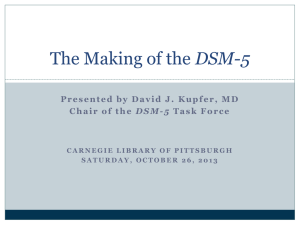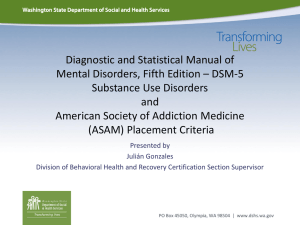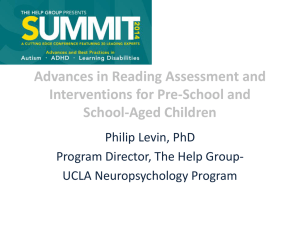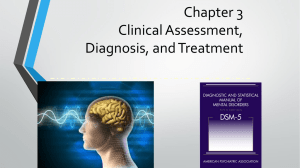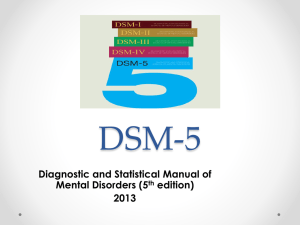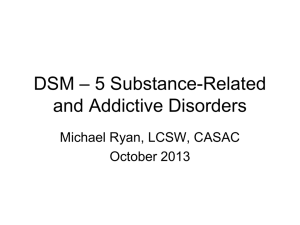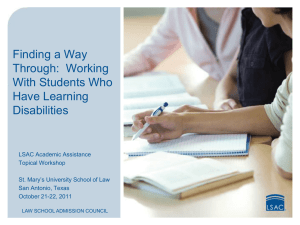DSM-5 and its use by chemical dependency professionals
advertisement
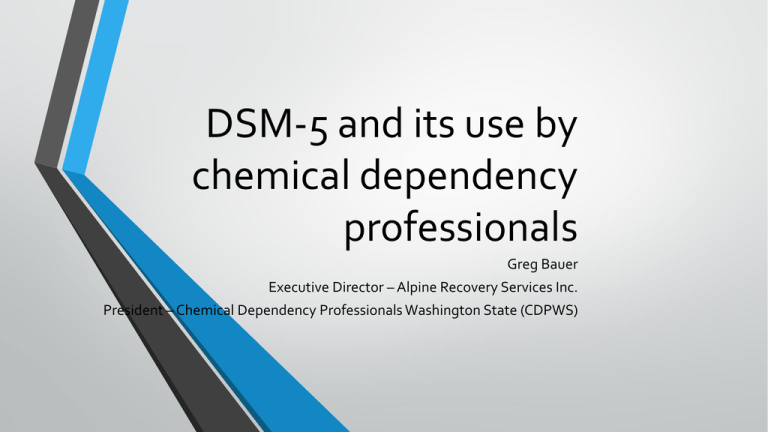
DSM-5 and its use by chemical dependency professionals Greg Bauer Executive Director – Alpine Recovery Services Inc. President – Chemical Dependency Professionals Washington State (CDPWS) DSM-5 - a brief history 1943 2013 1952 2000 1968 1994 1980 1987 DIAGNOSTIC AND STATISTICAL MANUAL OF MENTAL DISORDERS DSM-5 overview of changes in the DSM-5 • removal of Roman numeral to modern Arabic numeral • elimination of multiaxial diagnostic system • elimination of NOS designation • dimensional approach to diagnosis • cultural formulation changes specific to substance-related and addictive disorders • combines the DSM-IV categories of substance abuse and substance dependence into a single disorder • now have 11 criteria for substance-related disorders • eliminated criteria of recurrent substance related legal issues found in DSM-IV • added criteria of “craving, or strong urge to use” • called substance-related and addictive disorders changes specific to substance-related and addictive disorders • substance-related disorders divided into two groups substance use disorders substance-induced disorders • each disorder measured on a continuum from mild to severe • addition of first behavioral disorder, “gambling disorder” substance use disorder as defined by DSM-5 a problematic pattern of substance use leading to clinically significant impairment or distress as manifested by at least two of the following occurring in a 12-month period: substance use disorder as defined by DSM-5 1. substance is often taken in larger amounts or over a longer period of time than was intended 2. persistent desire or unsuccessful efforts to cut down or control substance use 3. great deal of time is spent in activities necessary to obtain the substance, use the substance, or recover from its effects 4. craving or strong desire to use the substance substance use disorder as defined by DSM-5 5. recurrent use resulting in failure to fulfill major role obligations at work, school, home 6. continued substance use despite having persistent or recurrent social or interpersonal problems 7. important social, occupational, or recreational activities are given up or reduced because of substance use substance use disorder as defined by DSM-5 8. recurrent substance use in situations in which it is physically hazardous 9. substance use is continued despite knowledge of having a persistent or recurrent physical or psychological problem that is likely to have been caused or exacerbated by the substance substance use disorder as defined by DSM-5 10.tolerance, as defined by either of the following: a. a need for markedly increased amounts of the substance to achieve intoxication or desired effect b. a markedly diminished effect with continued use of the same amount of substance substance use disorder as defined by DSM-5 11.withdrawal, as manifested by either of the following: a. b. characteristic withdrawal syndrome for the substance use of the substance or closely related substance is taken to relieve or avoid withdrawal symptoms diagnosis of substance use disorder social impairment (5 – 7) impaired control (1 – 4) risky use (8 – 9) 11 identified criteria pharmacological criteria (10 – 11) significant changes in diagnostic criteria • pharmacological criteria 10 and 11 which include withdrawal occurring during appropriate medical treatment with prescribed medications are specifically NOT counted when diagnosing a substance use disorder • “…the appearance of normal, expected pharmacological tolerance and withdrawal during the course of medical treatment has been known to lead to an erroneous diagnosis of addiction even when these were the only symptoms present.” significant changes in diagnostic criteria • “however, prescription medications can be used inappropriately, and substance use disorder can be correctly diagnosed when there are other symptoms of compulsive, drug-seeking behavior” severity and specifiers in the DSM-5 mild severe moderate DSM-5 recommends that in assessing severity clinician uses changes in frequency and/or dose of substance use individuals own report clinician’s observations report of knowledgeable others biological testing course specifiers in DSM-5 •early remission •sustained remission •in a controlled environment 10 classes of substances listed in substance-related disorders • alcohol • caffeine • cannabis • hallucinogens • inhalants 10 classes of substances listed in substance-related disorders • opioids • sedative-hypnotic, or anxiolytics • stimulants • tobacco • other (or unknown) non substance-related disorders • gambling disorder • only behaviorally based disorder listed in substance related and addictive disorder chapter • has nine specific criteria gambling disorder 1. needs to gamble with increasing amounts of money in order to achieve the desired excitement 2. 3. 4. is restless or irritable when attempting to cut down or stop gambling has made repeated unsuccessful efforts to control, cut back, or stop gambling is often preoccupied with gambling ( e.g., having persistent thoughts of reliving past gambling experiences, handicapping or planning the next venture, thinking of ways to get money with which to gamble) gambling disorder 5. 6. often gambles when feeling distressed (e.g., helpless, guilty, anxious, depressed) 7. 8. lies to conceal the extent of involvement with gambling 9. relies on others to provide money to relieve desperate financial situations caused by gambling after losing money gambling, often returns another date to get even (“chasing” one's losses) has jeopardized or lost a significant relationship, job, or educational or career opportunity because of gambling coding and reporting procedures • DSM-5 includes both ICD-9-CM and ICD-10-CM codes • ICD codes are listed as a coding note the following diagnostic criteria • example: 305.00 mild alcohol use disorder for ICD-9 • F10.10 mild alcohol use disorder for ICD-10 coding and reporting procedures • • • • please note that if intoxication, withdrawal, or substance induced mental disorders are also present, the comorbid use disorder code is utilized example: alcohol intoxication and alcohol use disorder mild, F10.129 for ICD-10 for classes of substances that have more than one substance, in addition to using the code that applies to the class of substance, also record the name of the specific substance example: 304.10 (F13.20) moderate alprazolam use disorder DSM-5 also now includes “provisional diagnosis” clinician can indicate diagnostic uncertainty by recording “(provisional)” following the diagnosis can be used when strong presumption that full criteria will be met but not enough information is available to make firm diagnosis principal diagnosis when more than one diagnosis is given in an inpatient setting, the principal diagnosis is the condition established after study to be chiefly responsible for locating the admission of the individual when more than one diagnosis is given in an outpatient setting, the reason for the visit is the condition that is chiefly responsible for the ambulatory care medical services received during the visit in most cases, the principal diagnosis or reason for visit is also the main focus of attention or treatment DSM-5 - three unique sections section I: introduction/use of the manual section II: diagnostic criteria and codes section III: emerging measures and models section III includes tools and techniques to enhance clinical decision-making, understand cultural context of mental disorders, and recognize emerging diagnosis for further study assessment measures cross-cutting symptom measure adult/child the adult measure is self rated across 13 domains the child measure is a parent/guardian rated measure across 12 domains Clinician rated dimensions of psychosis symptom severity eight item measure to be completed by the clinician at time of clinical assessment World Health Organization Disability Assessment Schedule 2.0 (WHODAS 2.0) 36 item measure that assesses disability in adults over age 18 assesses disability across six domains: • • • • • • understanding and communicating getting around self-care getting along with people life activities participation in society cultural formulation “understanding the cultural context of illness experience is essential for effective diagnostic assessment and clinical management.” culture: systems of knowledge, concepts, rules and practices that are learned and transmitted across generations cultures are open, dynamic systems that undergo continuous change over time race: a culturally constructed category of identity that divides humanity into groups based on a variety of superficial physical traits ethnicity: a culturally constructed group of identity used to define peoples and communities culture, race, and ethnicity are related to economic iniquities, racism, and discrimination that resulted health disparities outline for cultural formulation cultural identity of the individual cultural conceptualizations of distress psychosocial stressors and cultural features of vulnerability and resilience cultural features of the relationship between the individual and clinician overall cultural assessment cultural formulation interview 16 questions clinicians may use to obtain information during assessment regarding impact of culture on key aspects of the individual’s clinical presentation and care cultural concepts of distress refers to ways that cultural groups experience, understand, and communicate suffering, behavioral problems, or troubling thoughts and emotions cultural concepts are important to psychiatric diagnosis for several reasons: to avoid misdiagnosis to improve therapeutic efficacy to obtain useful clinical information to improve clinical rapport and engagement to guide clinical research to clarify the cultural epidemiology DSM-5 has also placed in section III proposed criteria and diagnostic features for the following caffeine use disorder internet gaming disorder neurobehavioral disorder associated with prenatal alcohol exposure for more information www.dsm5.org DSM-5 diagnostic criteria mobile app also available for IOS and android operating systems “ Thank you for listening and for attending. ” Greg Bauer Alpine Recovery Services Inc. greg.bauer@alpinerecovery.com 360.658.1388

